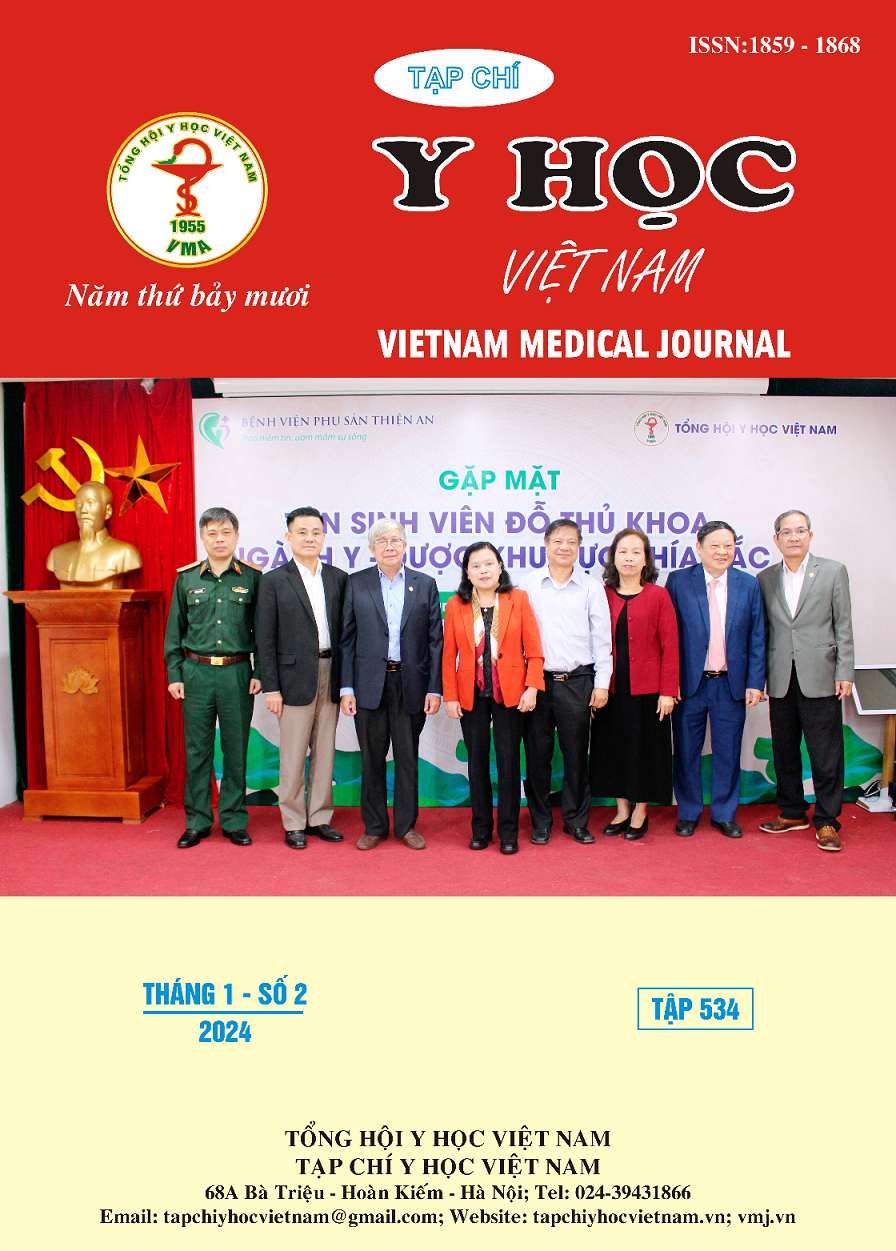CHARACTERISTICS OF FRAILTY SYNDROME IN SYSTEMIC SCLEROSIS PATIENTS AT CENTER FOR RHEUMATOLOGY – BACH MAI HOSPITAL
Main Article Content
Abstract
Objectives: Determine the prevalence of the frailty syndrome and its associated factors in patients with systemic sclerosis (SSc) at Centre for Rheumatology in Bach Mai Hospital. Subjects and methods: A cross-sectional study was conducted on 52 patients with systemic sclerosis according to the 2013 ACR/EULAR classification criteria between January 2023 and June 2023. Results: Frailty syndrome was revealed in 52 SSc patients for a prevalence of 76.9%, with the prevalence of mild, moderate, and severe frailty were 34.6%, 26.9%, and 15.4% respectively. Among the 10 variables included in the CRAF index, the high prevalence of fatigue (95%), comorbidity (80,8%), and polypharmacy (94,2%) were observed. Regarding factors related to frailty syndrome, the group with interstitial lung damage has a higher frailty syndrome rate (89.2% compared to 46.7%), the difference is significant with p=0.005, the group using immunosuppressive drugs has a higher frailty syndrome rate (91.4% compared to 47.1%), the difference is significant with p=0.005, Raynaud's syndrome increases the frailty syndrome rate (92.6% compared to 60%), the difference is significant with p=0.038; otherwise, it was studied not about age, gender, time since diagnosis, forced vital capacity and skin thickness. Conclusion: Patients with systemic sclerosis often have frailty syndrome, this condition is related to interstitial lung damage, Raynaud's syndrome, and the use of immunosuppressive drugs. Therefore, the patients need to be considered for frailty syndrome assessment to contribute to improving the quality of comprehensive health care.
Article Details
References
2. Fried LP, Hadley EC, Walston JD, et al. From Bedside to Bench: Research Agenda for Frailty. Sci Aging Knowl Environ. 2005;2005(31). doi:10.1126/sageke.2005.31.pe24
3. Hax V, Tessari J, Pena E, et al. Physical frailty in patients with systemic sclerosis. Seminars in Arthritis and Rheumatism. 2022;56:152077. doi:10.1016/j.semarthrit.2022.152077
4. Lưu Phương Lan. Đặc Điểm Lâm Sàng, Cận Lâm Sàng và Chức Năng Thông Khí Phổi Trên Bệnh Nhân Xơ Cứng Bì Hệ Thống. Luận án tiến sĩ y học. Đại học Y Hà Nội; 2015.
5. Gatta G, Di Grezia G, Iacomino A, et al. HRCT in systemic sclerosis: correlation between respiratory functional indexes and extension of lung failure. J Biol Regul Homeost Agents. 2013;27(2):579-587.
6. Collard RM, Boter H, Schoevers RA, Oude Voshaar RC. Prevalence of Frailty in Community‐Dwelling Older Persons: A Systematic Review. J American Geriatrics Society. 2012;60(8): 1487-1492. doi:10.1111/j.1532-5415. 2012.04054.x
7. Zanotto T, Galperin I, Mirelman A, et al. Frailty and Falls in People Living With Multiple Sclerosis. Archives of Physical Medicine and Rehabilitation. 2022;103(5):952-957. doi:10.1016/j.apmr.2021.10.025
8. Guler SA, Kwan JM, Winstone TA, et al. Severity and features of frailty in systemic sclerosis-associated interstitial lung disease. Respiratory Medicine. 2017;129:1-7. doi:10.1016/ j.rmed.2017.05.012
9. Bhorade S, Jablonski R, Lee J, et al. Frailty Measurements in Systemic Sclerosis Differ from Other Fibrotic Interstitial Lung Diseases. In: A37. connective tissue disease-interstitial lung disease. American Thoracic Society; 2019: A1429-A1429. doi: 10.1164/ ajrccm-conference. 2019.199.1_MeetingAbstracts.A1429


